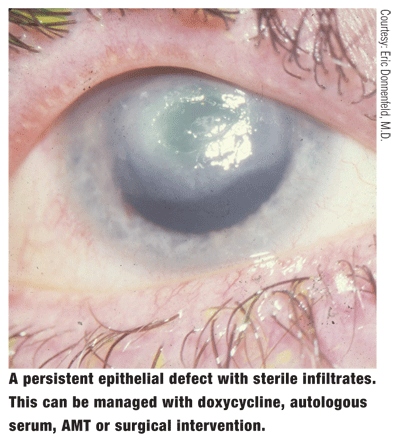 Q: A 64-year-old male patient developed neurotrophic keratitis (NK) secondary to herpes zoster ophthalmicus (HZO) and now has a persistent sterile corneal ulcer. What are my best treatment options?
Q: A 64-year-old male patient developed neurotrophic keratitis (NK) secondary to herpes zoster ophthalmicus (HZO) and now has a persistent sterile corneal ulcer. What are my best treatment options?
A: The most important and first option is to make sure that the eye has adequate coverage from a mechanical perspectivethat theres not a lid lag or some form of involvement of the facial nerve thats not allowing proper closure, says J. James Thimons, O.D., of Ophthalmic Consultants of Connecticut and Long Island. That can occasionally occur in a patient with a bad zoster infection.
Once youve ensured that the lids are not causing or worsening the patients condition, remove all preserved topical medications possible from the patients regimen, says Dr. Thimons.
The state of the ocular surface must be a primary concern. Remember that the eye is dry, and there may be prolonged exposure of the ocular surface due to a poor blink. I would use a bland, non-preserved tear to lubricate the eye; the preservative may be toxic to the eye, says Eric Donnenfeld, M.D., also of Ophthalmic Consultants of Connecticut and
Other non-surgical therapeutic interventions for NK include bandage contact lenses and amniotic membrane grafts. Bandage lenses offer a very easy therapeutic modality, but must be followed carefully, says Dr. Donnenfeld. Secondary infection is extremely common in NK and the use of bandage contact lenses.
Other therapeutic modalities that are not commonly used but that may be effective include oral tetracyclines, such as doxycycline 100mg b.i.d. Doxycycline blocks collaginase expression and also is a matrix metalloproteinase inhibitor, says Dr. Thimons. This helps reduce both the inflammation and the sterile ulceration.
 Restasis (cyclosporine 0.05%, Allergan) may be used in conjunction with doxycycline. Due to the neurotrophic nature of the cornea, there isnt a normal tear film, Dr. Thimons says. The Restasis stimulates lacrimal secretion.
Restasis (cyclosporine 0.05%, Allergan) may be used in conjunction with doxycycline. Due to the neurotrophic nature of the cornea, there isnt a normal tear film, Dr. Thimons says. The Restasis stimulates lacrimal secretion.
Other possible treatments for NK include:
Autologous serum. The patients own blood is spun down, and the serum acts to help heal the epithelium, Dr. Donnenfeld says. It contains fibronectin, laminin and other properties that aid epithelial healing.
Autologous serum usage has demonstrated resolution of neurotrophic keratitis with no side effects.1 In one study, patients who received drops five to 10 times dailyshowed complete resolution between six and 32 days. The epithelial disorder resolved and corneal scarring decreased.
When using this treatment option, consider punctal plugs to enhance the serums effect.
Amniotic membrane transplant (AMT). If a bandage is needed for a longer period of time, an amniotic membrane transplant can be sutured over the area, which will stabilize the ocular surface, provide a good aesthetic effect, and reduce inflammation, Dr. Donnenfeld says. This can be therapeutic, but it will not have long-standing effect if the eye is severely neurotrophic.
An advantage to AMT: Such a transplant has no chance of allograft rejection.2
Surgical intervention. If the patient does not respond quickly to this therapy, then surgical intervention is indicated and may be required to resolve NK following HZO, Dr. Donnenfeld says.
Two effective surgical treatments: tarsorrhaphy and conjunctival flaps. You can do a temporary suture tarsorrhaphy or use superglue: medical-grade cyanoacrylate, Dr. Thimons says. That will seal the lids for about seven days, and then it spontaneously extrudes after the epidermis grows in under it.
When creating a conjunctival flap, the surgeon mobilizes the conjunctiva from the bulbar area and places it over the area of neurotrophic keratitis. There, it acts as a bandage, Dr. Donnenfeld says.
Examine your patients condition upon presentation, and make sure that the therapy you prescribe is accurate for his or her level of NK. Evaluate the severity of the neurotrophic keratitis using a Cochet-Bonnet aesthesiometer to assess corneal sensation, Dr. Donnenfeld says. If it reads 0, then medical therapy will likely not help, and surgical therapy should be expedited.
If you dont have an aesthesiometer, he adds, you can remove the fibers from the end of a cotton swab and touch that end to the eye to assess the patients corneal sensation. Dental floss will also provide the desired effect.
Also, make certain to differentiate between peripheral ulcerative keratopathy and neuro- trophic keratopathy. The former is more inflammatory and more ischemic, and it is treated with oral steroids and cytotoxic immunosuppressants.
1. Astin CL. Amiodarone keratopathy and rigid contact lens wear. Cont Lens Anterior Eye 2001;24(2):80-2.
2. Shah GK, Cantrill HL,

